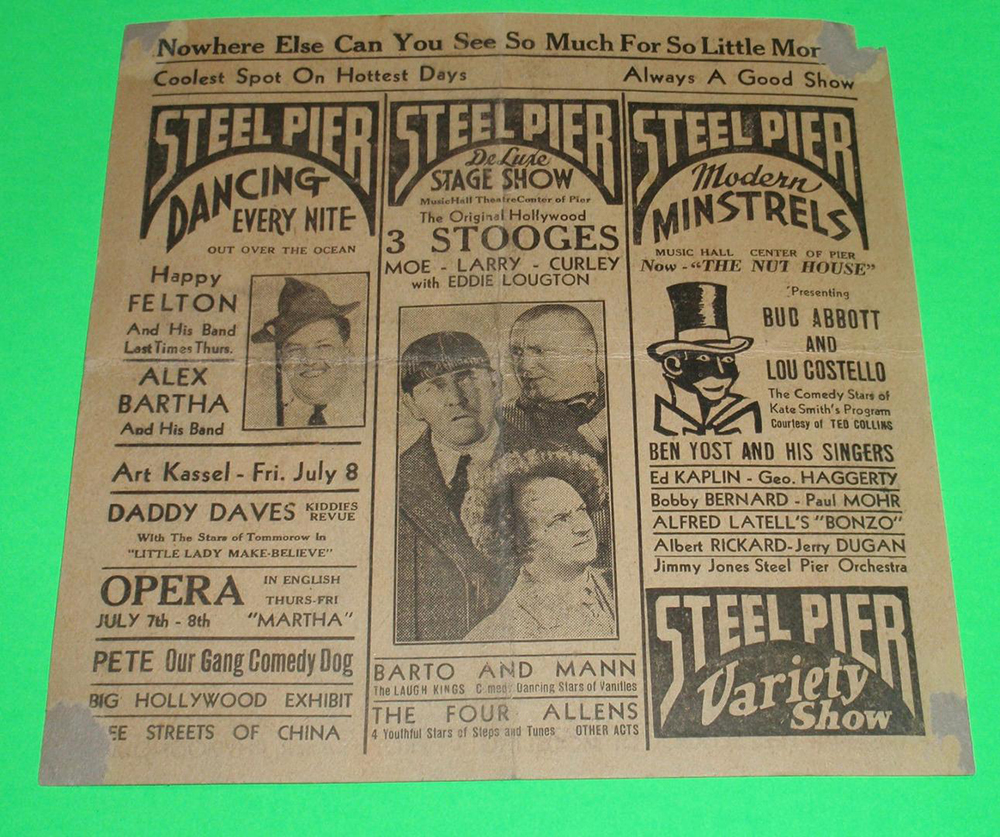By Bruce Klauber
In 1973, I was a journalism student at Temple University. Like many journalism students there at the time, I had hopes of landing a position at the Temple University News. But the clippings I had from my high school newspaper writings meant nothing to the news’ powers that be at the time. I was unceremoniously told to wait in line if I wanted any kind of position at the news.
Maybe my clips were lousy, but having been in the entertainment business for a dozen years by then, I decided to use whatever show biz “chutzpah” I had to get the newspaper’s attention.
Back then I was playing drums with Tommy DeNoble, a great singer who made his name as one of the “regulars” on Dick Clark’s “American Bandstand” television program, and a real gentleman who left us much too soon.
DeNoble’s full-time job was film director for what was then WTAF Television/Channel 29 in Philadelphia. In 1973, WTAF was broadcasting the old “Three Stooges” shorts every day.
I had recently read somewhere that Moe Howard of “The Three Stooges” would be doing his one-man show at Philadelphia’s TLA Cinema on South Street, and that he would be visiting the WTAF studios to publicize the show.
The wheels began to turn. Surely an interview with the legendary Moe of The Three Stooges would help get my foot in the door at Temple’s newspaper.
I asked DeNoble, a show business veteran who had no fear, if he would ask Moe during Moe’s visit to the station, about doing an interview with me.

DeNoble, who could charm anyone, came through. The interview with Moe was set on a weekday afternoon in the third-floor dressing room of the rickety old TLA.
I knocked on the door and behold, Moe Howard, then a white-haired, 76-year-old senior citizen, answered the door.
I introduced myself by telling him that I watched “The Stooges” on television every day since I was 8 years old, and that I saw them in person at Philadelphia’s old Latin Casino in 1959.
“You’ve got a lot of courage, son,” was Moe’s reply. I addressed him as “Mr. Howard.” He insisted I call him Moe. I was determined to ask questions that, to my knowledge, had been rarely asked.
“How long have you been doing a single?” was my first question. That floored him, as he told me almost everyone who had ever interviewed him had asked the same thing: “Did you guys ever get hurt while you were poking eyes and hitting each other on the head?”
Then we were off and running.
He explained that the act had been retired since Larry Fine had a stroke three years earlier, but that he was enjoying his one-man shows and occasional appearances on the Philadelphia-based “Mike Douglas Show.”
He revealed, among other things, that The Stooges resented Lou Costello of Abbott and Costello fame, because they believed that Costello got his comedy shtick directly from The Stooges’ Curly Howard. He also voiced his dissatisfaction with Columbia Pictures, who kept the team in two-reel film shorts, as opposed to Abbott and Costello, Laurel and Hardy, and other comedy teams who were making feature-length films.
The interview took an interesting turn when Moe started asking about me and my interests.
I told him of my life-long interest in jazz and he asked me if I had ever heard of Stan Kenton. When I told him I was a major Kenton fan, he said he was going to tell me a story he had never publicly told before.
It seems that Moe Howard, if you can believe it, was a major jazz fan and a major Kenton fan. He became a “Kenton convert” when he first heard the Kenton band in the summer of 1941 when the Kenton was playing on the Balboa Peninsula at Newport Beach in California.
He was so taken with the Kenton sound that he told the Steel Pier’s George Hamid that the Pier absolutely had to book Stan Kenton’s band to appear on the same bill with The Stooges during The Stooges’ Aug. 24 to Sept. 1, 1941 shows at the Pier.
“I told George Hamid that if he didn’t book Kenton, he wouldn’t get The Stooges,” Moe explained. The Three Stooges, at that time one of the biggest acts in the business, were simply too big to refuse.
Wow. Stan Kenton and The Three Stooges. Who would have thought?
Note: The Kenton band returned to the Steel Pier in the summer of 1951 and 1953. And on July 1, 1966, Kenton’s band played the Pier’s Marine Ballroom, while the top-billed act in the Music Hall was The Rolling Stones.
In line with the beginning of my career as a journalist, those running the Temple University News were sufficiently impressed with my “Stooges exclusive” story that I was asked to be on staff and contribute anything I wanted, at any time I wanted.
As for The Three Stooges, it’s true that most men love them, and most women hate them. Like “I Love Lucy,” “The Three Stooges” comedy shorts are shown on television, somewhere in the world, every day of the year. And some 50 years after Moe, Larry and Curly – and Curly’s various successors – performed as a team, the boys, as they are still called, are as popular as ever.
Currently, there are nearly 20 books about The Three Stooges in print, with two on Shemp Howard on the way. Among the most impressive is “A Tour De Farce: The Complete History of The Three Stooges on the Road,” a 758-page work that details, for the first time, virtually every personal appearance the comedy team made.
Written by suburban Philadelphia native Gary Lassin, who has long served as Three Stooges Museum executive director (The Stoogeum in Ambler, Pa.) and The Stooges’ Fan Club president (2,000 members and counting), the book is the result of 20 years of research. For those familiar only with the team’s televised film shorts and latter-day films, is a real eye-opener.
The Stooges never made big money from their films and were not legally entitled to royalties when their famed film shorts were first sold to television in late 1958. The boys made their real money from the 1,500 in-person stage shows in which they starred over the years.
When I first heard about Lassin’s book – and recalled the story Moe Howard told me about The Stooges’ bringing Stan Kenton to Atlantic City – I got to thinking about the team’s association, if there was one, with Atlantic City through the years.
Lassin, needless to say, had all the details. Aside from the personal appearances, Larry Fine and his wife, Mabel, lived at Atlantic City’s President Hotel, at Albany Avenue and the Boardwalk, for years. It seems Mrs. Fine detested cooking and housekeeping, and preferred hotel living – first at the President, and later at Hollywood’s Knickerbocker Hotel.
The Stooges’ formal association with Atlantic City came by way of their first Steel Pier appearance on July 24, 1936. The following year, from Aug. 21 through Aug. 27, the team moved over to the Pier’s competitor, Million Dollar Pier.
A funny piece of home movie film of The Stooges clowning on the Boardwalk, which can be viewed on YouTube, was filmed during the Pier appearance of July 1 through July 7 of 1938. In August of 1939, the team was a part of the popular “George White’s Scandals” touring review that played at the theater on Atlantic City’s Garden Pier.
A Labor Day Weekend series of shows back at the Steel Pier in 1941, this time with the Kenton band on the bill, was a time Moe Howard always remembered vividly.
“The one I will never forget is that weekend at the Steel Pier in Atlantic City,” Moe recalled years later. “We usually did 28 minutes in our theater routine, but that weekend at the Steel Pier, we did 12 shows a day, so we had to cut our act down to seven minutes, which was just enough time to enter on stage, tell three jokes, and do two pieces of stage business. It was really a horrible situation. Lunch was a sandwich backstage with a glass of orange juice and the same for dinner, as there was no time to leave the dressing room.”
Such was the price of popularity.
A summer, 1942, Steel Pier appearance of Moe, Larry and Curly was the team’s last until 1959.
Vaudeville comics like The Stooges, Abbott and Costello, Eddie Cantor and The Ritz Brothers had been staples of Steel Pier stage shows for years, but by the late 1940s, Steel Pier bookings in the Music Hall began to focus more on music than comedy.
The Stooges and Abbott and Costello were busy making films in Hollywood, and the hottest comedy team around was Dean Martin and Jerry Lewis, an “adult” act who worked in Atlantic City exclusively at The 500 Club. There just weren’t a lot of family comedy acts appropriate for the Steel Pier around by the late 1940s and 1950s.
George Hamid made an exception on Aug. 9 through Aug. 15 of 1959, when he again booked The Three Stooges – with Curly-Joe DeRita in place as the third stooge – into the Music Hall. Hamid almost had to.
Since the Stooges’ old film shorts were released to television in 1958, the veteran slapstick trio, who were considered washed-up by then, made one of the most miraculous comebacks in the history of show business.
Kids saw these old films on television programs like Sally Starr’s “Popeye Theater,” and the youngsters just had to see these three human cartoons in person.
Moe and Larry broke in the new stooge, comedy veteran Joe DeRita, and hit the personal appearance road yet again, to places like Philadelphia’s Latin Casino, The Holiday House outside of Pittsburgh, and state fairs and theaters all over the country.
And yes, they were no longer making two-reel film shorts. Between 1959 and 1970, the team made or appeared in nine feature films, made dozens of television guest spots, starred in a live action/animated television series, were featured in television commercials, and were part of a merchandising barrage that included Stooges’ comic books, recordings, trading cards, etc.
The Three Stooges had finally attained the most elusive quality in the entertainment industry: respect. And George Hamid had to have them at the Steel Pier. Those who were there remember nothing but packed houses.
They returned for their final Pier appearance a year later – from June 26 through July 2, 1960 – in tandem with a blockbuster booking that starred Ricky Nelson. The Three Stooges, in all likelihood, never appeared in Atlantic City again. George Hamid probably couldn’t afford them.
The Three Stooges continued, with a considerable amount of success until 1970, when a stroke put Larry Fine out of action.
Moe Howard made a number of single appearances all over the country and on television through 1975, and even Larry Fine did a few in the Hollywood area when his health allowed. When the act “retired” in 1970, Curly-Joe DeRita tried booking something called “The New Three Stooges,” but it just didn’t work.
In 1975, Moe Howard announced that The Three Stooges would get back together again, with Emil Sitka (“hold hands, you lovebirds”) in place of the ailing Larry Fine, and Joe DeRita again appearing as Curly-Joe. A film project, something called “Blazing Stewardesses,” was announced, but Moe kept putting the start date off. He passed away on May 4, 1975, and Larry Fine died some four months earlier on Jan. 24. The Ritz Brothers appeared in the film in place of Moe, Emil and Curly-Joe.
A journalist has got to start somewhere, and there’s usually someone to thank for facilitating this start. In my case, it wasn’t a great editor or novelist or college professor who helped get me going in this business. It was Moe of The Three Stooges.
Special thanks to Gary Lassin for his help in researching this article. For more information on his book, visit www.tourdefarce.net.
Bruce Klauber is the author of four books, an award-winning music journalist, concert and record producer and publicist, producer of the Warner Brothers and Hudson Music “Jazz Legends” film series, and performs both as a drummer and vocalist.














